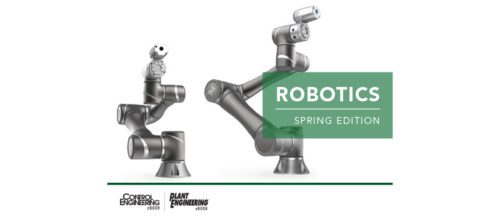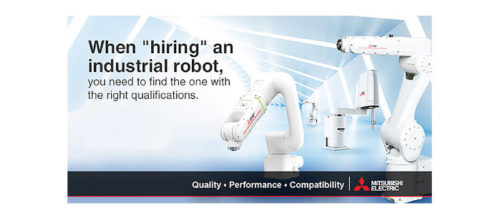Robots and automation save jobs; standards help
Manufacturing competitiveness, expansion of embedded machine vision, and greater collaboration among humans and automation are hot technology topics, according to representatives for industry associations for robotics, machine vision, and motion control in advance of the annual A3 Business Forum.
Preservation of manufacturing jobs, rapid expansion of embedded vision systems, and greater collaboration between humans and automation are among key trends in robotics, machine vision, and motion control. These issues and related standards developments were among topics discussed in advance of the A3 Business Forum, Jan. 18-20, with Jeff Burnstein, president, Association for Advancing Automation (A3), and Carole Franklin, director of standards development, Robotic Industries Association (RIA). More than 500 attendees are expected to participate in the automation technology conference. A3 organizations are RIA, Motion Control and Motor Association (MCMA), and AIA (Advancing Vision and Imaging).
CFE Media: Are robotics specifically and automation in general being seen more as an opportunity for manufacturing competitiveness and profitability, rather than a threat to labor?
Burnstein: Yes. Being unable to compete is what kills jobs, not automation. Look at a company like Marlin Steel in Baltimore, a small company that was getting killed by Chinese competition until they automated. Drew Greenblatt, the company’s owner, says that if not for automation, Marlin would have zero jobs today. Instead, it has increased headcount at the company after automating, now actually export to China, and have better, safer and higher paying jobs than ever before.
CFE Media: What do market trends in machine vision, robotics, and motion control tell us about how these technologies are being applied?
Burnstein: The main trends I see: embedded vision is shaking up the machine vision industry, while collaborative robots are shaking up the robotics industry. Every major camera company and robot supplier is investigating how to develop products (if they don’t have them already) to participate in these technology shifts. People and automation working together is the main trend for the future.
CFE Media: How are some industry growth areas, such as medical applications, electric vehicles, and additive manufacturing affecting A3 markets and members?
Burnstein: With robotic assistance, medical surgeries are becoming less invasive, and there are new options for much finer control. As well, mobile robots are helping transport small medical payloads around hospitals, improving efficiency and quality of patient care within hospitals. The automotive space continues to be the most automated vertical and was responsible for a large percentage of 2016’s robotics purchases. And, obviously, we’re hearing more today about the impact of additive manufacturing. I believe nearly all of our 1,000-plus members in RIA/AIA/and MCMA are affected by a future with greater use of this technology.
CFE Media: What key standards have been updated lately (or will soon to be updated) that could affect members of the A3 associations?
Franklin: The current version of the Industrial Robot Safety Standard, ANSI/RIA R15.06-2012, is a U.S. national adoption of the ISO 10218-2011, Part 1, Robots, and Part 2, Robotic Systems. These standards will continue to be the current versions at least through 2020. Look for new versions of these documents in the 2020 or 2021 timeframe.
Outside the robot-specific world, there are some other standards on industrial safety that our members may want to know about. These are the recently updated ANSI/ASSE Z244.1 on Lockout, Tagout and Alternative Methods, published in late 2016; and the B11.20 on Safety Requirements for Integrated Manufacturing Systems, which is being updated right now, with an anticipated publication date in 2017. (For more on standards developments from Franklin and others, watch for the March issue of Control Engineering.)
CFE Media: How is integration of robotics with people and processes (workflows) becoming easier?
Burnstein: Certainly the emergence of collaborative robots has helped with integrating robots quickly into a process. They don’t require any special fencing or safety guarding equipment And with easy programming, all of this allows people and robots to work together quickly and easily.
CFE Media: How and why are in-person automation shows and conferences, like the Automate 2017, still relevant and helpful for the industry?
Burnstein: Automate 2017 (April 3-6, Chicago) plays a vital function for educating companies on how to successfully apply robotics, vision, motion control, metrology and related automation technologies. Companies who are just now beginning to evaluate these technologies (especially small- and medium-sized companies) come to Automate to see the products, talk to system integrators about potential applications, and compare suppliers. At the same time they can talk to experts on the show floor and in conference sessions. Experienced users attend as well to see the latest advances and determine what new applications they should be considering. The internet is great, but it doesn’t replace the face-to-face connections made at trade shows, which is why strong shows like Automate continue to flourish.
CFE Media: Are there accomplishments in AIA, RIA, and MCMA from 2016 (or plans in 2017) you’d like to highlight?
Burnstein: Our combined membership in these associations now tops 1,000 (1,032 at the end of 2016, to be exact). Each of the associations ended the year with a record number of members. We’re growing by more than 10% a year now, a strong indicator of the interest in automation and the benefits association provides. In fact, we had record attendance at our annual National Robot Safety Conference, our annual A3 Business Forum, our biannual International Collaborative Robots Workshop, our TechCon event, Vision 2016, and I could go on and on about the records we set in 2016.
CFE Media: What other areas haven’t we discussed that you’d like to comment on?
Burnstein: I’d like to stress how important robot safety is, which is why RIA is so committed to developing safety standards at the national and international level. As collaborative robots enter the workplace in greater numbers, it’s critical that risk assessments are conducted (just as it is with traditional robots). Our director of standards development, Carole Franklin, mentioned some new standards and documents developed in 2016 and future plans. We’re also working on a mobile robot safety standard as mobile robots become a key technology development.
Mark T. Hoske is content manager, CFE Media, Control Engineering, mhoske@cfemedia.com. A3 is a CFE Media Content Partner.
ONLINE extra
A3 Business Forum, Jan. 18-20, Lake Buena Vista, Fla.
Automate 2017 (April 3-6, Chicago)
See other automation events in the Control Engineering event calendar, upper right, at www.controleng.com.
Do you have experience and expertise with the topics mentioned in this content? You should consider contributing to our CFE Media editorial team and getting the recognition you and your company deserve. Click here to start this process.




